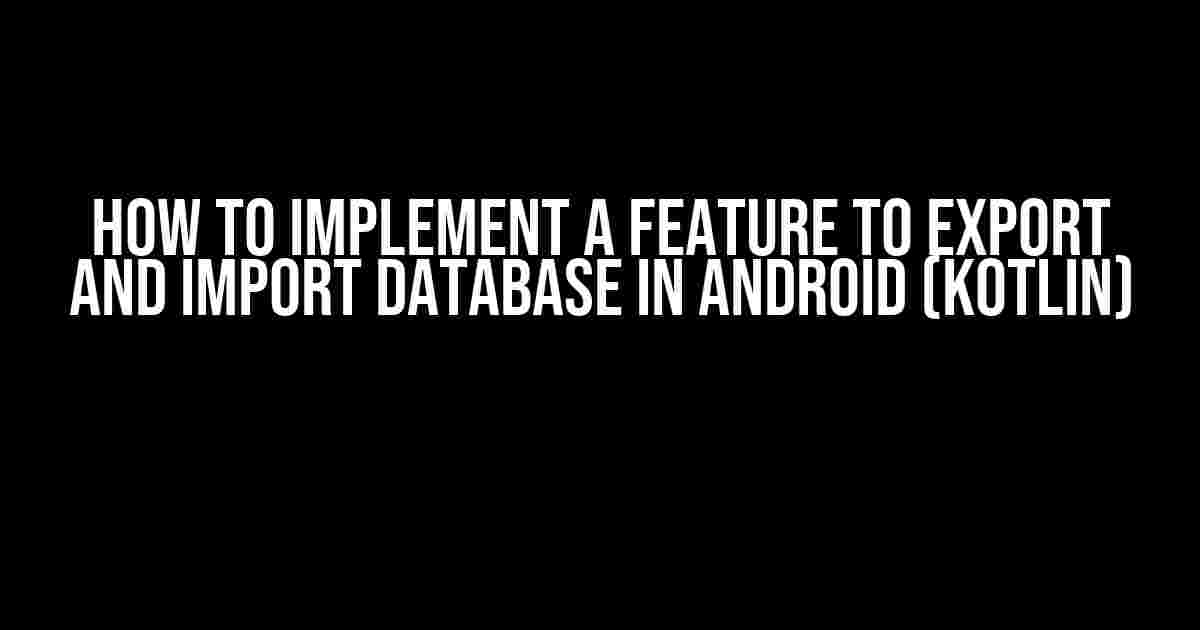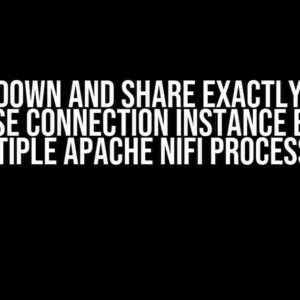As a mobile app developer, you often face the daunting task of managing and maintaining your app’s database. One of the essential features that can make your life easier is the ability to export and import database data. In this article, we’ll guide you through the process of implementing this feature in your Android app using Kotlin.
Why Export and Import Database is Important?
Exporting and importing database data is crucial for various reasons:
- Data Backup and Recovery**: Exporting database data allows you to create a backup of your app’s data, which can be used to recover data in case of a crash or data loss.
- Data Sharing**: Exporting data enables users to share their progress or data with others, which can be useful in multiplayer games or collaborative apps.
- Data Migration**: When updating your app or migrating to a new database, importing data ensures minimal disruption to your users’ experience.
Choosing the Right Database for Android
Before diving into the implementation, it’s essential to choose the right database for your Android app. Some popular options include:
| Database | Pros | Cons |
|---|---|---|
| SQLite | Embedded, lightweight, easy to use | Limited scalability, no concurrent access |
| Realm | Fast, flexible, easy to use | Commercial license required for large-scale apps |
| Room Persistence Library | Part of Android Architecture Components, easy to use | Requires additional setup, not suitable for complex queries |
In this article, we’ll use SQLite as our database of choice, but the concepts can be applied to other databases as well.
Step 1: Setting up SQLite Database in Android (Kotlin)
To use SQLite in your Android app, you need to add the following dependencies in your build.gradle file:
dependencies {
implementation 'androidx.sqlite:sqlite:2.1.0'
}
Create a SQLite database helper class, DatabaseHelper.kt, to manage your database:
class DatabaseHelper(context: Context) {
private val dbHelper = SQLiteOpenHelper(context, "mydb", null, 1)
fun getWritableDatabase(): SQLiteDatabase {
return dbHelper.writableDatabase
}
fun getReadableDatabase(): SQLiteDatabase {
return dbHelper.readableDatabase
}
}
Step 2: Exporting Database Data
To export database data, you’ll need to create a method that retrieves the data from your database and saves it to a file. Create a new class, DatabaseExporter.kt:
class DatabaseExporter(private val dbHelper: DatabaseHelper) {
fun exportDatabase(): Boolean {
val db = dbHelper.getReadableDatabase()
val cursor = db.query("mytable", null, null, null, null, null, null)
val exportData = StringBuilder()
if (cursor.moveToFirst()) {
do {
// export data logic here
exportData.append("${cursor.getString(0)},${cursor.getString(1)},${cursor.getString(2)}\n")
} while (cursor.moveToNext())
}
cursor.close()
val file = File(Environment.getExternalStorageDirectory(), "exported_data.csv")
val fileWriter = FileWriter(file)
fileWriter.write(exportData.toString())
fileWriter.close()
return true
}
}
In this example, we’re exporting data from a table named “mytable” and saving it to a CSV file named “exported_data.csv” in the app’s external storage directory.
Step 3: Importing Database Data
To import database data, you’ll need to create a method that reads data from a file and inserts it into your database. Create a new class, DatabaseImporter.kt:
class DatabaseImporter(private val dbHelper: DatabaseHelper) {
fun importDatabase(file: File): Boolean {
val db = dbHelper.getWritableDatabase()
val csvReader = CSVReader(FileReader(file))
val contentValues = ContentValues()
csvReader.readNext() // skip header
while (csvReader.readNext()) {
contentValues.put("column1", csvReader.get(0))
contentValues.put("column2", csvReader.get(1))
contentValues.put("column3", csvReader.get(2))
db.insert("mytable", null, contentValues)
}
csvReader.close()
return true
}
}
In this example, we’re reading data from a CSV file and inserting it into the “mytable” table in our database.
Integrating Export and Import Features into Your App
To integrate the export and import features into your app, create a new activity or fragment that will handle the export and import functionality. In this example, we’ll create a new activity, DatabaseManagerActivity.kt:
class DatabaseManagerActivity : AppCompatActivity() {
private lateinit var dbHelper: DatabaseHelper
private lateinit var databaseExporter: DatabaseExporter
private lateinit var databaseImporter: DatabaseImporter
override fun onCreate(savedInstanceState: Bundle?) {
super.onCreate(savedInstanceState)
setContentView(R.layout.activity_database_manager)
dbHelper = DatabaseHelper(this)
databaseExporter = DatabaseExporter(dbHelper)
databaseImporter = DatabaseImporter(dbHelper)
findViewById<Button>(R.id.export_button).setOnClickListener {
databaseExporter.exportDatabase()
Toast.makeText(this, "Database exported successfully!", Toast.LENGTH_SHORT).show()
}
findViewById<Button>(R.id.import_button).setOnClickListener {
val file = File(Environment.getExternalStorageDirectory(), "import_data.csv")
databaseImporter.importDatabase(file)
Toast.makeText(this, "Database imported successfully!", Toast.LENGTH_SHORT).show()
}
}
}
In this example, we’re creating an activity with two buttons: one for exporting the database and one for importing the database. When the export button is clicked, the exportDatabase() method is called, and when the import button is clicked, the importDatabase() method is called.
Conclusion
In this article, we’ve covered the steps to implement a feature to export and import database data in your Android app using Kotlin. By following these steps, you can ensure that your app’s data is safely backed up and can be easily shared or migrated to a new database.
Remember to always consider security and performance when handling database data, and adjust the export and import logic according to your app’s specific requirements.
Happy coding!
Frequently Asked Question
Are you tired of feeling stuck trying to implement a feature to export and import your database to your Android app in Kotlin? Worry no more! Here are some answers to get you started:
What is the best way to export my database from my Android app?
You can use a library like SQLiteAssetHelper to export your database as a SQL file. This library provides a convenient way to manage your database and export it to a file. Alternatively, you can use the `sqlite3` command-line tool to export your database.
How can I import a database into my Android app?
To import a database into your Android app, you can use the same SQLiteAssetHelper library. Simply copy the SQL file into your app’s assets folder and use the library to import it into your app’s database. You can also use the `sqlite3` command-line tool to import the database.
What format should I use to export my database?
The most common format for exporting a database is SQL, which is a plain text file that contains the database schema and data. This format is widely supported and can be easily imported into most databases. Alternatively, you can use a binary format like DB file, but SQL is generally the most flexible and convenient choice.
How can I secure my database export and import process?
To secure your database export and import process, you should consider encrypting the database file using a library like SQLCipher. This will protect your data from unauthorized access. You should also ensure that your app has the necessary permissions to read and write files, and that you’re using a secure connection to transfer the database file.
Are there any third-party libraries that can help me with database export and import?
Yes, there are several third-party libraries available that can help you with database export and import. Some popular options include Room persistence library, Realm, and SQLBrite. These libraries provide a convenient way to manage your database and export it to a file, and can also help you with data migration and synchronization.


